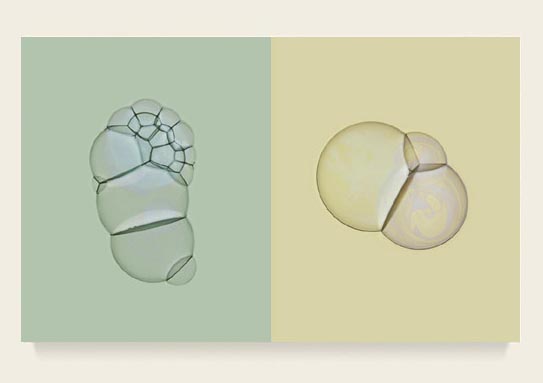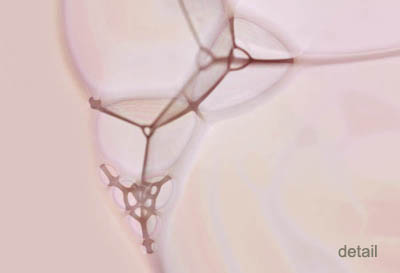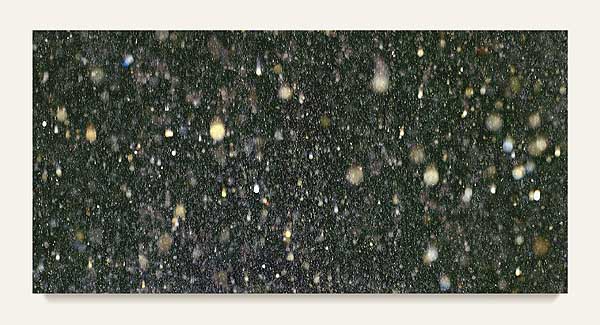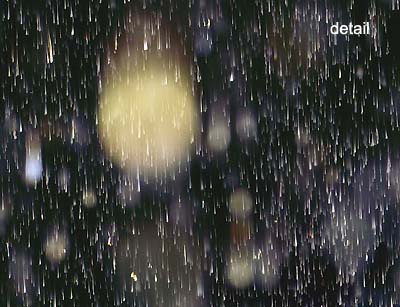Photographic Works: Rainscapes | In bed with Lucy and Dolly | Way of Words English - Deutsch << home : david fried - contemporary art / kunst
Photographic works
In bed with Lucy and Dolly - Color Photograms (analogue)
Mapping the temporal balance between water and air in the form of unique bubbles—which emerge as a result of dynamic systems that do not follow linear and hierarchal patterns of organizational behavior—Fried charts the fundamental economy of fluid networks in nature. In varying chromatic tones, Fried depicts strictly non-biological membranes that evoke a strong resemblance to primordial living cells or biotech test-tube creations, and reminds us of just how fragile, yet adoptive the architecture of life is.
Fried creates large gaseous vesicles in a totally darkened room using infrared goggles. At the decisive moment before they fall, he photograms them onto grainless color sheet-film by triggering a colored point-light source above. He captures the shadows of these fleeting objects to make an image on a photosensitive support using only light and the light sensitive material. No camera or lens is used.
What we see in his enlarged c-prints are the latent shadows and spectral aberrations of these transparent forms caused by the membrane’s curved surface. The object itself becomes the lens, subtly bending the light and altering its own image.
The series title refers to Lucy as the early hominin ‘mother’, to Us as the ‘myth-makers’, and to Dolly the cloned sheep, as to what Fried ironically calls the ‘missing link’, in a mythological dialogue that seeks orientation in a world in which man has moved from adapting to and controlling their environment, to designing life itself to fit it’s environment. With this work, Fried involves our sense of orientation in a world that has taken a biomorphic journey from the Cambrian sea to the sea of science and it’s playpens of genetic engineering.
in bed with lucy and dolly No.32, No.36, 2003, color photograms, archival c-prints on diasec, alu. 130 x 200 cm
In bed with Lucy and Dolly - Farb-Fotogramme (analog)
Indem er die flüchtige Balance von Wasser und Luft in Gestalt einzigartiger Luftblasen aufzeichnet – hervorgegangen aus dynamischen Systemen, die keinem hierarchisch-linearen Muster organisierten Verhaltens folgen – kartografiert Fried eine fundamentale Ökonomie der flüssigen Vernetzung in der Natur.
In verschiedenen Farbtönen bildet er durchweg nichtbiologische Membranen ab, die große Ähnlichkeit mit den ersten lebenden Zellen oder Schöpfungen aus den Biotech-Laboren aufweisen und uns vor Augen führen, wie fragil, aber auch anpassungsfähig die Architektur des Lebens ist.
In einem komplett abgedunkelten Raum erzeugt Fried, ausgestattet mit einer Infrarotbrille, große Gasblasen. Im entscheidenden Augenblick, kurz bevor sie fallen, bannt er ihr Fotogramm auf kornlosen Farbfilmbögen, indem er darüber eine punktförmige, farbige Lichtquelle aktiviert. So fängt er die Schatten dieser flüchtigen Objekte ein, erzeugt auf einem fotosensiblen Träger ihr Bild, das nur unter Verwendung von Licht und lichtempfindlichem Material entsteht. Weder Kamera noch Objektiv sind hier im Spiel.
Auf den vergrößerten C-Prints kommen die verborgenen Schatten und Spektralabweichungen der transparenten Formen zum Vorschein, welche von der gekrümmten Oberfläche der Membran herrühren. So wird hier der Gegenstand selbst zur Linse, bricht unmerklich das Licht und verändert so das Abbilden seiner selbst.
Der Titel der Werkgruppe bezieht sich auf Lucy, die Urmutter der Menschheit, auf uns als „Mythenschöpfer“ und auf das Klonschaf Dolly, das Fried ironisch als „Missing Link“ bezeichnet in jenem mythologischen Dialog, der sich in einer Welt zu orientieren versucht, in der sich Menschen nicht mehr bloß der Umwelt anpassen oder diese kontrollieren, sondern dazu übergehen, das Leben zu formen und sich ihre Umgebung dadurch selbst anzupassen. Mit diesem Werk schärft Fried unseren Orientierungssinn in einer Welt, die auf eine lange Reise des Formenwandels zurückblickt, vom Meer des Kambriums, bis hin den Versuchsteichen der Wissenschaft mit ihren ersten Schöpfungen der Gentechnik.
DETAIL: in bed with lucy and dolly, No.40, farb fotogramm
Rainscapes - Photography (analogue)
At first glance, the colorful arrays of countless water drops in Fried’s Rainscape photographs appear to be falling galaxies—clusters of dripping light painted on the night sky. On closer inspection one sees that they are actually photographs of pure falling rain.
Fried captures strongly individual patterns of rainfall on large format color film. Rich chromatic variations are revealed by the prismatic effect of light passing through each individual raindrop, evoking a spacious cosmic look. His large-scale Rainscape photographs exude a quiet replenishing quality that unloads poetically within the viewer.
Observing what gives rise to civilizations, or may ultimately lead to their demise, Fried sees freshwater as an issue of great importance in the 21st century. Since ancient times, with prayer and rituals, to science and its methods, humans have wished to influence the weather. And although the collective human pursuit has undoubtedly had profound affects on the ecosystem, we are luckily still unable to control bigger systems such as the weather. Rain still falls freely through the world’s skies and harvesting hands before completing it’s cycle. However, access to—and usage of—clean water is being moved into increasingly privatized hands, servicing industry and profit more than local needs and down-river ecosystems. Fried’s Rainscapes portray sweet water at its birth and invites us to contemplate its worth as we become its temporary custodians.
Interview exerpt: Meier Stadtmagazin | November 2007
The inspirational kick for my Rainscape works came in April 1995 on the Canary island of La Palma. Events there inspired an ongoing series of non-digital large-format photographs of pure falling rain. The story goes: I was staying at a rented hut by a farmer family doing watercolors. They told me it hadn’t rained a drop in over one and a half years on the west side of the Island where we were. One day I bicycled up the 2400 meter volcano through the clouds, getting wet by them at 2000 meters, and I instantly felt rejuvenated. Later that night at a big local outdoor Fiesta, I began a spontaneous 6 hour rain dance – yeah, the live 17 piece band was incredible too! The 150 or so town folk and farmers thought I was totally nuts, but the kids really had fun joining in. The next day it actually did rain and the following night, all the farmers in the area brought me fruit and homemade wine in sincere thanks and wonder.
Weather is something that throughout the ages, humans have wished to influence and control. In 2003 there was a record drought in normally overcast Germany where I stay, and it was then that I began to document every nighttime rainfall possible with an elaborate technique, which includes 8x10” film and up to 20,000 watts of flash. This is because my subject matter is essentially transparent and wants to stay that way.
Rainscape No.1, 2003. archival c-print on aluminum, 125 x 256 cm
Rainscapes - Fotografie
Bunte Reihen zahlloser Wassertropfen – Frieds Rainscapes wirken auf den ersten Blick wie taumelnde Galaxien, an den Nachthimmel gemalte Cluster aus tropfendem Licht. Bei genauerem Hinsehen erkennt man, dass es sich tatsächlich um Aufnahmen von fallendem Regen handelt.
Fried fängt die äußerst individuellen Muster des Niederschlags auf großformatigem Farbfilm ein. Die große Vielfalt an Farben, hervorgebracht durch den prismatischen Effekt, wenn Licht durch jeden einzelnen Regentropfen fällt, evoziert den Eindruck eines kosmischen Raums. Seine großformatigen Rainscape-Fotos strahlen etwas Stilles, Erfüllendes aus, das sich in poetischer Weise auf den Betrachter überträgt.
Bei der Frage, was zum Aufstieg von Zivilisationen führt oder schließlich ihren Niedergang besiegeln mag, ist für Fried das Thema Trinkwasser im 21. Jahrhundert von größter Bedeutung. Schon früh waren Menschen von dem Wunsch getrieben, das Wetter zu beeinflussen, sei es durch Gebete und Rituale, sei es durch Methoden heutiger Wissenschaft. Und obwohl dieses allen Menschen gemeinsame Streben ohne Zweifel tiefgreifende Einflüsse auf das Ökosystem hatte, sind wir zum Glück bis heute nicht in der Lage, so umfassende Systeme wie das Wetter zu kontrollieren.
Noch immer fällt das Wasser als Regen frei vom Himmel auf die Erde und die bäuerlichen Hände, bevor es seinen Kreislauf vollendet. Doch der Zugang zu Trinkwasser und seine Nutzung werden zunehmend privatisiert, was eher der Industrie und dem Profit dient als einem lokalen Bedarf und den Ökosystemen der Flüsse. Frieds Rainscapes porträtieren Frischwasser in seiner Ursprünglichkeit, sie lassen uns über seinen Wert nachdenken und für einen Moment auch sein Hüter sein.
DETAIL: Rainscape No.1,
Way of Words | Motiongrams (analogue)
Fried’s series ‘Way of Words’ is a series of images or ‘motiongrams’ captured with long exposures of his ‘SOS’ sound stimulated sculptures, reacting and moving in realtime to the artist’s spoken words.
They document both the initial stationary constellations and the fluid actions of the interactive spheres that ensues as the artist speaks selected quotes to them. The starting points are known, the outcomes are not. As audible information informs the motion of the interactive sculpture, each motiongram contains the message it heard, resulting in unique calligraphic symbols, in a highly probabalistic language.
The actual quote the SOS heard is the subtitle of each image. In several series, Fried has chosen quotes to speak from musicians, authors, philosophers and activists, about love, community, language and the mind.
The associative mind is hard-wired to percieve relevant patterns where there are none, better than failing to see a possibly dangerous pattern where one exists.
Like words in any language are merely metaphors—symbols of what we attach to them, like art, they have a unique power to move us. And while most people will agree to a general or dictionary meaning, the word love for example, will mean different things to each individual according to their experience. And not unlike the appreciation of abstract art—beyond aesthetics—gazing upon a written alphebet and language that is strange to us, excercises our perceptual dexterity as we look for clues, patterns and meaning.
Fried plays with this phenomena between literal and associative interpreted meanings within and without ourselves. He gives us a clue through the title—a quote with literal meaning—and simultaneously offers us a non-literal language-relevant visual ‘glyph’ to mentally map our associative thinking.
Literacy is a challenging adventure—we‘ve all been there as kids. As adults, when learning new languages on the fly, we relive this highly corralitive process. Body language or comic books for example, are classic image-based narratives that help to learn the meaning of a new languague.
Fried’s Way of Words motiongrams reverse, and even feeds-back this perceptual process on itself. Visualizing qualities of language through chance and emergent complexity, he invites us to loop through the literal, metophoric and subjective realms of our associate mind.
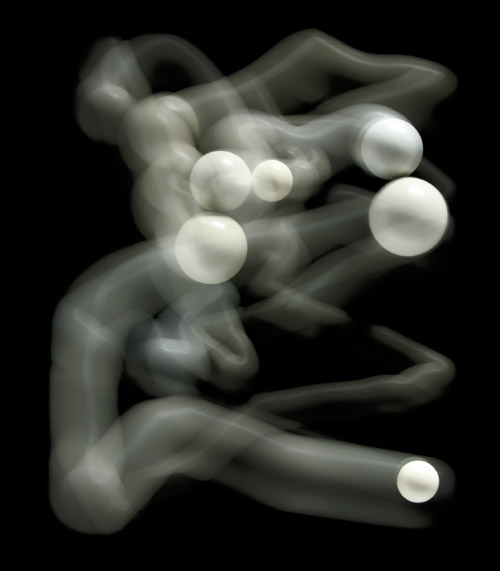
Way
of Words, No.12, “All words, in every language, are metaphors”
- Marshall McLuhan
2008, archival C-print, 23 x 26 cm. edition 8
Way of Words | Motiongrams (analog)
Frieds Fotoserie Way of Words besteht aus einer Reihen von Bildern oder „Motiogrammen“, die von seinen akustisch stimulierten SOS-Skulpturen mit langer Belichtungszeit gemacht wurden, während sie auf vom Künstler gesprochene Wörter in Echtzeit mit Bewegung reagierten.
Sie zeigen sowohl die ursprüngliche Konstellation als auch die schemenhaften Verlaufswege der interaktiven Kugeln, die sich daraus ergeben, dass der Künstler ausgewählte Zitate vorliest. Der Ausgangspunkte sind klar, die Resultate sind es nicht.
Da den Bewegungen der interaktiven Skulptur hörbare Information zugrunde liegt, trägt jedes Motiogramm die gehörte Aussage auch in sich, so dass daraus einzigartige kalligrafische Bilder in einer hochgradig probabilistischen Sprache entstanden sind.
Das für ein SOS verwendete spezielle Zitat ist Bestandteil des jeweiligen Bildtitels. In verschiedenen Serien benutzte Fried Zitate von Musikern, Romanciers, Philosophen und Aktivisten, es geht darin um Liebe, Gemeinschaft, Sprache und Bewusstsein.
Das assoziative Denken ist darauf programmiert, Bedeutungsmuster auch dort wahrzunehmen, wo gar keine sind, was immer noch besser ist, als ein echtes und womöglich gefährliches Muster zu verpassen. So wie Wörter einer beliebigen Sprache bloß Metaphern sind – Symbole dessen, was wir ihnen zuschreiben – haben sie wie die Kunst doch eine einzigartige Macht über uns. Und während wohl die meisten Menschen einer allgemeinen Bedeutung oder Wörterbuchdefinition zustimmen würden, besagt etwa das Wort „Liebe“ für den Einzelnen ganz unterschiedliche Dinge, je nach seiner oder ihrer persönlichen Erfahrung. Und ganz so wie das Gefallen an abstrakter Kunst – jenseits ästhetischer Kategorien – trainiert auch das Betrachten eines in fremder Sprache geschriebenen Alphabets unser Wahrnehmungsvermögen, weil wir nach Schlüsseln, Mustern und Bedeutung suchen.
Fried spielt mit solchen Phänomenen zwischen buchstäblichen und assoziativ interpretierten Bedeutungen, die mit oder ohne unser Zutun entstehen. Mit dem Titel liefert er uns einen Schlüssel – das Zitat in seiner buchstäblichen Bedeutung –, doch zugleich liefert er den übertragenen Sinn einer sprachlich codierten, visuellen „Glyphe“, um unser assoziatives Denken auf den Weg zu bringen. Lesen lernen ist ein Abenteuer und eine Herausforderung – aus der Kindheit kennen wir das alle. Wenn wir als Erwachsene nebenbei neue Sprachen lernen, erleben wir diesen hochgradig korrelativen Prozess aufs Neue. Körpersprache oder Comics zum Beispiel sind klassische, auf Bildern basierende Narrative, die uns dabei helfen, die Bedeutung einer neuen Sprache zu lernen.
Frieds Motiogramme in Way of Words kehren diesen Wahrnehmungsprozess um, ja, lenken ihn sogar auf sich selbst zurück. Indem Fried Eigenschaften von Sprache durch Zufall und wachsende Komplexität visualisiert, lädt er uns ein zu einer Reise, die durch die buchstäblichen, metaphorischen und subjektiven Denkweisen unseres assoziativen Geistes führt.
On Photography in general
"(...) Since Gutenberg’s press first liberated the written word - making information and communication more available to the masses - a lot has happened in the age of reproduction. However, soon after the printing press was celebrated, this powerful tool was also abused, and as people became mistrustful, they began to regard printed material more skeptically; hence the saying "To lie like Print“ was born.
To reform this notion, the graphic revolution and photography offered us so-called objectivity, and people began to say; "A picture is worth a thousand words“, in spite of the somewhat subjective role a photographer may play.
But it wasn‘t long before this medium also became the most powerful tool for manipulating consensus. From the cut-and-paste faked photos of yesteryear - to today‘s digitally created images, the photographic medium has utterly lost its credibility when presented as a factual record. And through the wide spread of PC‘s and programs like Photoshop, our sense of perceiving photographic images as reality has become so corrupted, that today we have no other choice but to say; "A picture lies like a thousand words“.
In turn, this situation gives rise to a new generation of photographic art that is liberated from the constructs of objective reality and our perceptual illiteracy. We are seeing more use of the photographic medium by visionary artists with a focus on concept and imagination.
And even though photography had once ejected painting from its previous depictive role, the presence of digital-style imagery in painting trends today ironically suggests that painting has become occupied by its own liberator. The power of this relatively young medium has once again had an impact on painting, one of the oldest and perhaps sincere forms of art. Does this reflect a certain dependency or addiction to reality-based but manipulated imagery in our cultures today? (...)“ - DF 2006
note: all photographic artworks on this site are non-digitally created.
<< home Photograms: page 1 page 2 page 3 Photography: page 1 page 2
